Craignaw
(NX 463 833) 450m E facing, (SMC Lowland Outcrops 2004 page 184)
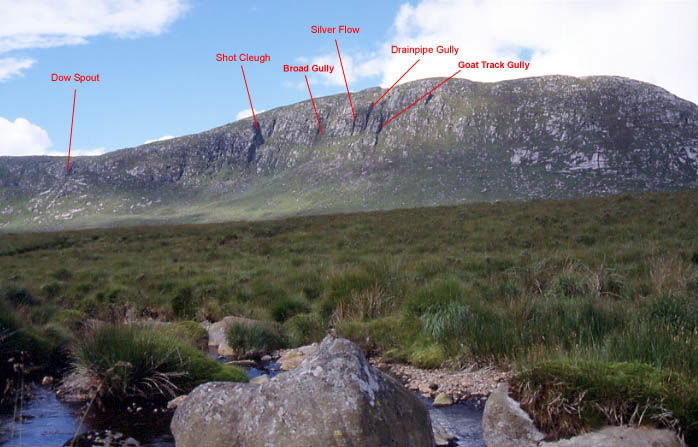
Above: Craignaw and the main lines, taken from Cooran Lane across the Silverflowe.
Below: Craignaw in winter, with the obvious icefall of Dow Spout on the left. The main gullies are hard to discern from this angle.
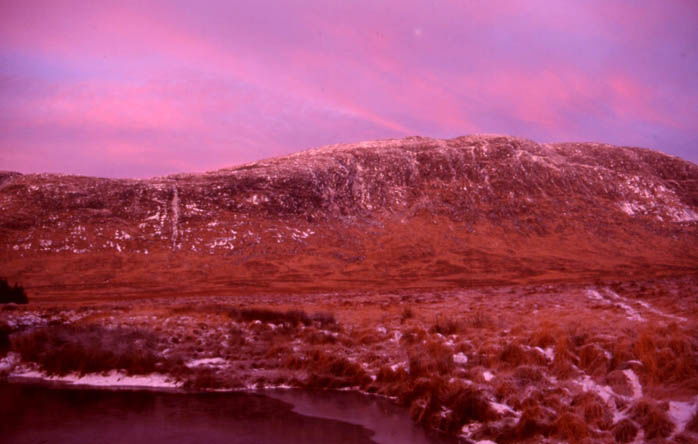
Given a good freeze, Craignaw is the second most important winter venue in Galloway after the Merrick, with major lines like Drainpipe Gully (III 4*), Silver Flow (IV 4**), and the magnificent Dow Spout (II/III***). In recent years a lot of icy mixed routes have been added, and there is probably scope for a few more. Of these latter climbs, the best are Hidden Chimney (IV 5*), Silver Sliver (IV 3*), The Sleigh Team (III 4*) and Full Metal Jacket (II/III).
About a week of heavy night frosts following rain are required for Dow Spout to form, and the other routes need similar conditions (though not the rain); plus a good dusting of snow would not go amiss either.
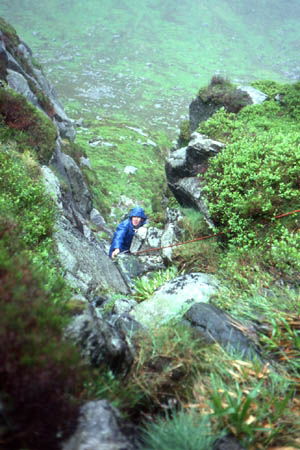
Willie Todd on the first summer ascent of Drainpipe Gully (VD) (Andrew Fraser)
Drainpipe Gully (III) - first winter ascent
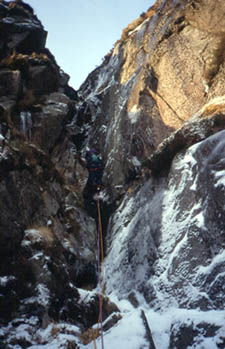
Andrew Fraser on the first pitch.
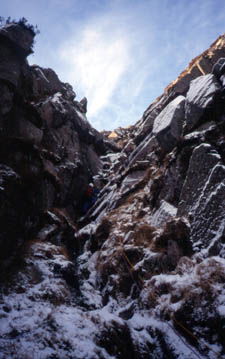
Ian Magill on the second pitch.
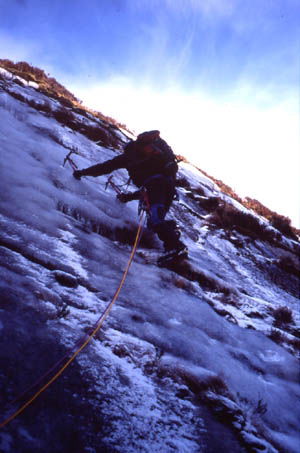
Stephen Reid leading the top pitch. (Fraser)
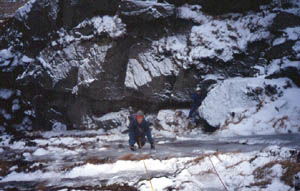
Andrew Fraser on the top pitch, whilst Ian Magill awaits his turn
Easier routes such as Goat Track Gully (II) and Broad Gully (II) would best best climbed under heavy snow cover, though they were first climbed on water ice.
Silver Flow (IV) - second winter ascent
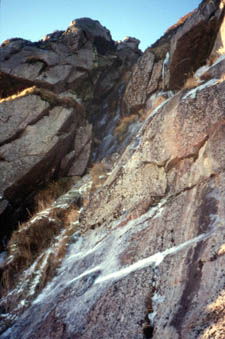
The deep cleft taken by the route.
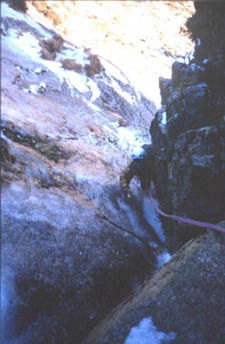
Jim Fotheringham on the first pitch.
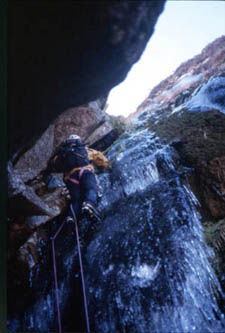
Jim Fotheringham starting the second pitch.
HISTORY - WINTER
The true first ascent of Dow Spout is uncertain, and it has had several claimants over the years. The earliest definite ascent is that of Mike Gennaro and Calum MacNee in February 1991; however Eric Christison had soloed a line in this area in 1987. The route was subsequently rediscovered and claimed, firstly by Jim Lawrence and Simon Mortlock, and subsequently by Andrew Fraser and Jim Thompson. Fraser also soloed it as a (wet!) summer line (VD) in 2003.
In 1994 Stuart Lampard and Jim Thompson passed by Dow Spout on their way to making the first ascent of Silver Flow, but the lack of previous rain meant there was no sign of an icefall, and also that they met with thin conditions on their route. It was better in 2002 when Stephen Reid and Jim Fotheringham made the second ascent of Silver Flow and added a direct finish and also repeated Dow Spout.
Two days previously Reid had also been involved in the first winter ascent of Drainpipe Gully with Fraser and Ian Magill. Fraser had made the first summer ascent of this climb (with Willie Todd and Alan Sloan) in 1981!
In January 2003 eight new routes were added to the crag, either by Fraser and Magill, or by a large team centred around Reid, consisting of Alan Hinkes, John Biggar, and Steve Prior. Perhaps the best memory on this occasion was Hinkes taking a call on his mobile whist sat at the top of Dow Spout - from Kathmandu!
Photo left: Dow Spout in winter - the route advances in steps with each step gradually getting steeper and longer, culminating in a superb final pitch. Climber Jim Fothingham.
Photos Below Left & Right: Dow Spout - two more veiws - climber: Jim Fotheringham.

Andrew Fraser and Ian Magill after the first winter ascent of Drainpipe Gully
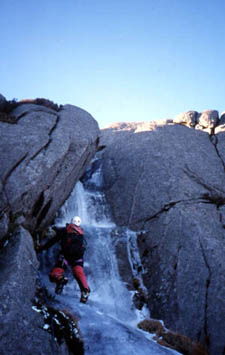
John Biggar making the first ascent of the Direct Finish to Goat Track Gully (IV).
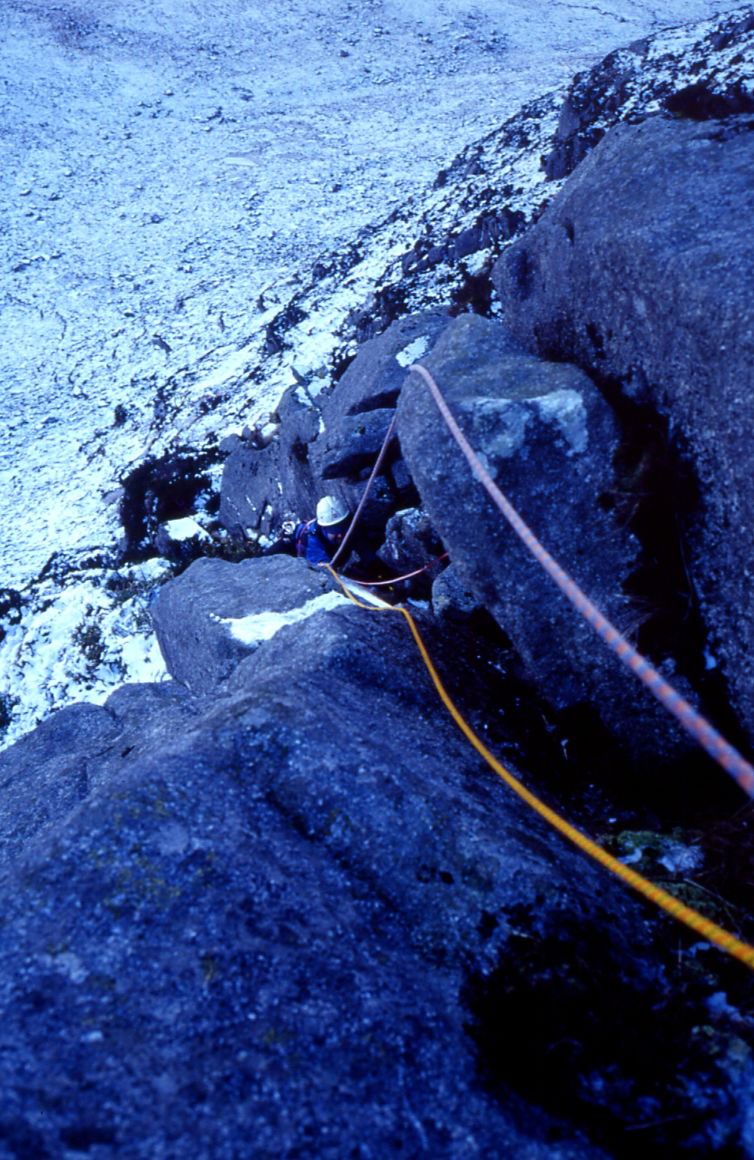
Ian Magill on the first ascent of the top pitch of The Sleigh Team (III 4*). (Andrew Fraser).
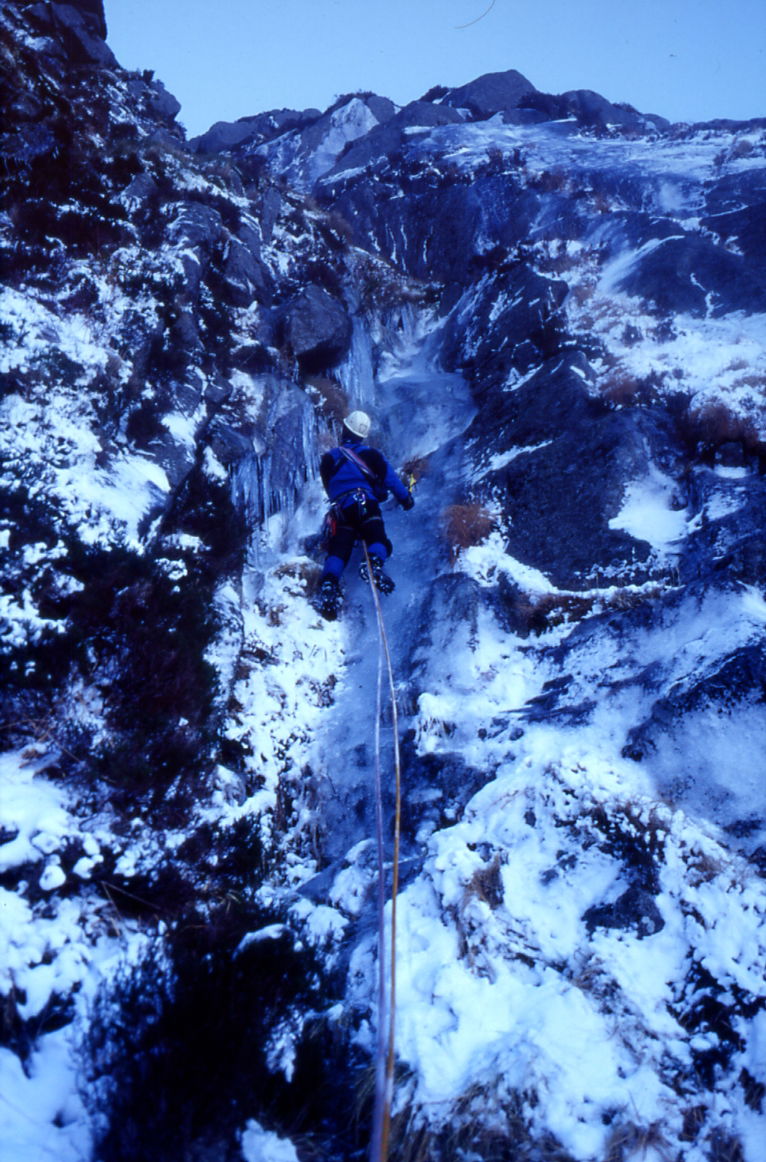
Ian Magill on the first ascent of Full Metal Jacket (II/III). (Andrew Fraser).
CRAIGNAW SLABS (NX 462 839) Alt 450m North East Facing
The slabs lies low down on the north-east end of Craignaw, just a short detour from the approach to the excellent crags on Dungeon Hill. Approach the slabs as for the Dungeon crags, in about 30 minutes across the Silver Flowe from Backhill of Bush bothy. The first route here was on Scotland Slab, named for the rough resemblance of the upper slab to a map of Scotland, and the remaining slabs take their names accordingly. Approach as for the Dungeon, in about 30 minutes across the Silver Flowe from the Backhill of Bush Bothy.
Newfoundland
The leftmost slab gives some of the most ungradeable routes in Scotland, let alone Galloway. Maybe they are just boulder problems with long walk-offs! Descents are possible either side.
Going for a Gander 100m+ Easy! Crosses the slab at two-thirds height in either direction - the crux is stepping over the wet streak. A useful descent.
Nova Scotia 60m D *
Climbs the left-hand side of the slab, the best start being 3m left of an obvious vertical crack in the lowest overlap (runner), with a St. Andrews Cross etched in veined relief on the slab above and left (hence the name).
| GG |
Going for a Gander |
E |
| NS |
Novia Scotia |
D |
| IB |
Icebergs |
D |
| TT |
Titanic |
S |
(4b). Make a tricky mantelshelf or rockover move leftwards onto the slab, or climb the crack. Continue easily up the middle slab to an overlap and runners at 40m, then finish up the slightly steeper top slab on nice pockets.
John Biggar, Ian Brown, 3rd June 2009
Icebergs 50m D*
Climbs the right hand side of the slabs about 5m left of Titanic. The crux "flop" start will be at least a grade easier if climbed with a full layer of fleece rather than a T-shirt and shorts! Start at a flake with a finger crack behind it.
(4b). From the top of the flake make an awkward mantelshelf/flop over onto the slab above. Recover and climb the fine second tier to reach the main slab. Walk up this crossing two crevasses, then continue climbing upwards and leftwards to a hidden belay.
Ian Brown, John Biggar, 3rd June 2009
Titanic 50m S **
(4c). At the right hand end of the crag is an obvious arête. This route climbs the steep wall about one metre left to a huge jug, then onto the slab. Cross the two crevasses above and step onto the fine 4m wall above the second one. Continue up the right hand edge of the slab above before trending left to belay.
John Biggar, Ian Brown, 3rd June 2009
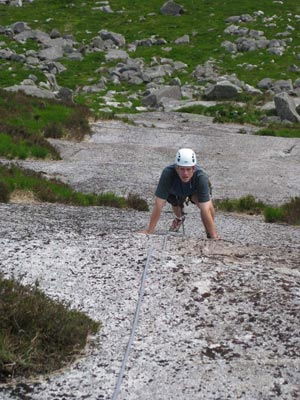
Ian Brown on the first ascent of Novia Scotia (D).
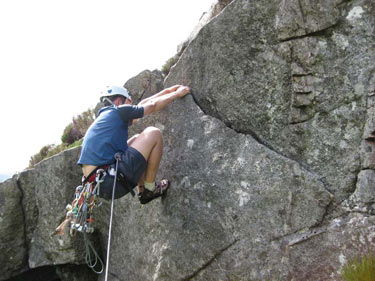
Ian Brown on the first ascent of Icebergs (D).
(Photos: John Biggar).
Atlantic Slab
The middle slab is unfortunately too low an angle to give any proper climbing and can be climbed anywhere at Easy or Moderate.
Scotland Slab
The slab is named for the resemblance of the upper slab to a map of Scotland and is a nice relatively low angled granite slab. It steepens from roughly 35º at the base in deepest Cumbria to nearly 50º in Sutherland. Protection is very sparse, but belays are good, 60m ropes recommended. The route still has some lichen on the easier sections, but the hardest moves have been cleaned. The slab will need several days to dry after heavy rain.
The Road to Wrath 100m HS **
1 50m (3c). From the lowest point of the slab climb easily up and right to cracks and runners at 30m (The Border). Continue straight up between two grass patches, then traverse leftwards to belay on the lower rocks of the upper slab, just west of Glasgow.
2 50m (4a). Step over the overlap and traverse further leftwards to reach a thin crack through the steeper slab above. Climb this crack for a few metres before a traverse can be made back right to Inverness . Make a tenuous move to a good pocket here then up diagonally left to Cape Wrath . Belay using a cracked block a few metres up and left. (The direct line up the A9 from Glasgow to Inverness is also good, but a very unprotected lead).
Linda Biggar, John Biggar, James Kinnaird, 25th June 2006
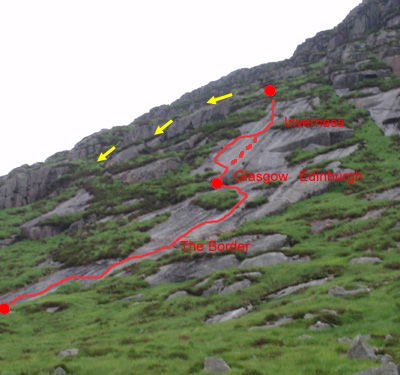
Scotland Slab
(Biggar coll.)
North Sea Slab
The foot of this slab is about 30m or 40m right of the mid-height on Scotland Slab. There is just one route on this slab so far and the top 5 metres could do with being a bit cleaner before anyone makes another ascent. The main lower slab is very nice although unprotected and the finish will be good when cleaner - indeed the route will probably be only Severe once properly hoovered.
Flounder 45m VS
(4a). Start at the very toe of the slab and climb the pleasant and easy but unprotected lower slabs to runners at 20m. Continue up towards the obvious triangular niche and enter it from the left. Flounder awkwardly up and leftwards (currently very grassy and mossy) to eventually reach block belays on a large grass terrace.
John Biggar, Ian Brown, 3rd June 2009
MEMORIAL CRAG (NX 458 833) Alt 600m West Facing
This small crag of impeccably clean granite sits immediately below the summit of Craignaw and overlooks Loch Neldricken. Just below the crag is a memorial to two US Airforce pilots who were killed in a plane crash here in 1979. On a sunny day it is an idyllic spot with wonderful views. It is, however, also a long way from anywhere and can be approached (by the ultra enthusiastic) either as for the Dungeon of Buchan, or from Glen Trool (2hrs 30mins minimum). However, from a campsite on the shore on Loch Neldricken, the crag could be easily reached in half an hour.
Although the routes are short, a double rack of cams up to Friend 4 should be considered the minimum, whilst wires are of little use.
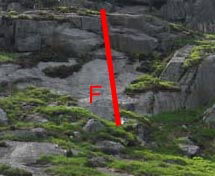
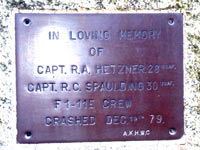
The bronze plaque on the memorial reads "In loving Memory of Capt RA Hetzner 28 USAF, Captain RC Spaulding 30 USAF, F1-11E Crew, Crashed December 19th 79, AKHWC"
Memorial Crag. Main Wall is on the left, and Zebra Wall is the striped wall above the grass ledge on the right. Click the picture for a larger photo.
| MS |
Mij's Slab & Mij's Chimney |
D/VD |
BB |
Back to Bax |
S |
| CC |
Captains' Crack |
E1 |
FG |
Frog Grooves |
VS |
| MW |
Memorial Wall |
E2 |
F1 |
F-111 |
VS |
| AC |
Aerial Combat |
E1 |
ZB |
Zebra |
VS |
| GD |
General Dynamics |
E1 |
CR |
Craignaw Corner |
E1 |
| MH |
The Murder Hole |
E2 |
CA |
Cameater Crack |
VS |
| GE |
Granny Eggface |
E2 |
SD |
Sword of Damocles |
S |
| AA |
Aardvark |
VS |
|
|
|
Main Wall
Main Wall is very steep, and home to some of the hardest routes in the Galloway Hills, with potential for even harder ones.
At the left end of Main Wall are easy angled slabs leading to grass ledge below a steep headwall.
Mij's Slab 10m D
The slab can be climbed anywhere, to a walk off left, or continue up Mij's Chimney on the left which is steep to start (8m VD).
J Biggar (solo), 2nd June 2006
Descended immediately beforehand (solo) by Mij the Border Terrier (in full control) much to the astonishment of the rest of the party! Mij's Chimney added by SJH Reid, J Biggar, 15th June 2006.
Just left of centre of Main Wall is an obvious slightly left slanting crack system
Captains' Crack 23m E1 5b **
Steep and strenuous, but thankfully juggy, and will take as many cams as you can carry. Follow the crack system to awkward moves to overcome a bulge and gain a grass ledge ledge. Move up to a smaller grass ledge on the right and finish up the left slanting cracks above.
SJH Reid, J Biggar, L Biggar, S Baxendale , 1st June 2006
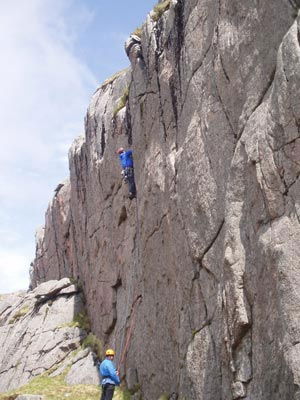
Stephen Reid and John Biggar on the first ascent of Captains' Crack (E1). (Biggar coll.)
Memorial Wall 23m E2 5c ***
Excellent steep, strenuous and well-protected climbing up the centre of the wall. Start in the centre of the wall, just left of Dynamics Direct. Climb a short layaway crack and swing left to a flat jug. Climb up slightly leftwards to an illusory rest and then make hard up rightwards to grab a hollow horizontal spike and gain a narrow ledge. The short wall and crack above hold interest to the last.
C King, SJH Reid, 15 th June 2006
Aerial Combat 22m E1 5b **
Another fine well protected wall climb. The next obvious feature, some 5 metres to the right, is a short left facing groove that leads at 4 metres to a long, almost horizontal, crack leading rightwards. Climb the groove and gain the ledge at the start of the horizontal flake, then climb up leftwards via hollow flakes to a block. Move left and then climb the wall above trending rightwards to a hard finishing move.
C King, J Biggar, SJH Reid, 15 th June 2006
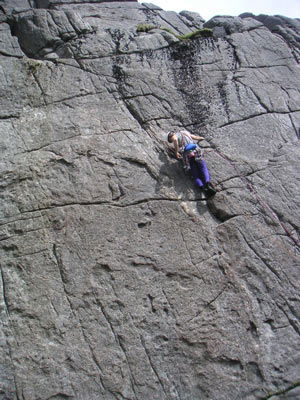
Chris King on the first ascent of Memorial Wall (E2). (King coll.)
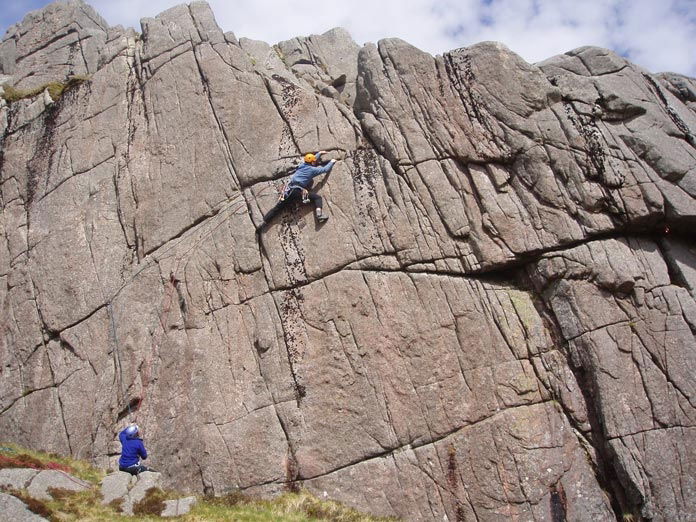
Photo Above: John and Linda Biggar on the first ascent of General Dynamics (E1). (Biggar coll.)
General Dynamics 25m E1 5b ***
A great route – Mainly HVS with a puzzling and reachy but reasonably protected crux. Start as for Aerial Combat. Climb the groove and hand traverse the crack rightwards with a long thin reach to gain a good hold on a block. Commit to this to make a wild swing right into a shallow groove up which the climb finishes.
J Biggar, L Biggar, SJH Reid, 1st June 2006
Towards the right side of Main Wall are two grooves capped by overhangs.
The Murder Hole 14m E2 6a *
The left hand groove gives a very sustained and technical route. Climb the groove up to the roof and make tenuous moves up and leftwards to finish up the last few moves of General Dynamics. Hard for the grade.
C King, SJH Reid, 15 th June 2006
Granny Eggface 12m E2 5c *
The right hand groove is also quite a toughie. Step up rightwards from two blocks then move left to a slot. Pull directly over the roof with difficulty and continue with more difficulty leftwards to the top.
C King, SJH Reid, 15 th June 2006
Aardvark 10m VS 4b
Immediately round to the right of Main Wall is a short left leaning slab with a crack on its left side in the upper half. Climb the slab which is not particularly well protected.
J Biggar, SJH Reid, 2002
Back to Bax 10m S 4a
Just right of the slab of Aardvark is a short trench-like groove/crack system. Climb this to a ledge then make a hard move up right to finish. Better (and harder) than it looks.
S Baxendale , L Biggar, 1st June 2006
Notable for being the first new route climbed by an all female team in the Galloway Hills.
Frog Grooves 15m VS 4c
Down and left of Back to Bax is a cleaner parallel line. Climb this to an exit right on to a grass ramp, or continue direct (5a). Finish up the wall above the ramp.
L Biggar, J Biggar, SJH Reid, 1st June 2006
Zebra Wall
To the right of Main Wall is a short wall below a long grass ledge and above this is a more attractive and slightly larger wall. The following climbs lie on the upper wall, just left of the scramble up to the grass ledge.
F-111 8m VS 4c
The wide crack on the left side of the wall becomes easier after a hard start.
J Biggar, SJH Reid, C King, 1st June 2006
Zebra 10m VS 4c *
Start towards the left side of the upper wall, and climb the prominent left slanting crack system with a hard move near the middle. A good sustained route.
L Biggar, J Biggar, 15th June 2006
Craignaw Corner 15m E1 5b *
Just right again is a smooth left-facing corner. Bridge strenuously up the corner and then tackle the twin cracks in the headwall. A good wee pitch.
SJH Reid, C King, J Biggar, 15th June 2006
Just right again are twin crack systems.
Cameater Crack 15m VS 4c
The left-hand crack soon eases off.
J Biggar, SJH Reid, C King, 15th June 2006
Sword of Damocles 15m S 4b *
The right-hand crack is more sustained and interesting.
J Biggar, SJH Reid, 15th June 2006
The sword, which was of an impressive size, was removed by the second en route and can be inspected at the foot of the crag.
Photo Right : John Biggar and Chris King on the first ascent of Cameater Crack (VS). Craignaw Corner takes the groove just left of the belayer. (King coll.)
Low on the western flank of Merrick, and close to Craignaw, CRAIG NELDRICKEN (NX 447 843) is a south-facing crag of excellent granite but unfortunately only 20m high and 2 hours hard walking from Glen Trool. So far it boasts only one pleasant route, Red Otter Day (Severe, 1994) which takes the grooved rib to the left of the gully towards the left end of the crag. It was the work of Stephen Reid and John Campbell.
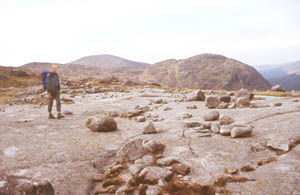
"The Devil's Bowling Green" on Craignaw, Mulwarchar and Dungeon Hill behind.
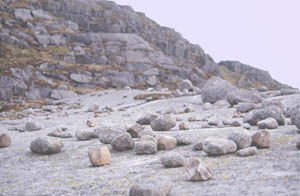
Another view.
The southern end of Craignaw is known as SNIBE HILL or POINT OF THE SNIBE (NX 465 815). Two Difficults were climbed here in the '50s by Gordon Waldie but not recorded fully. Three more climbs were made in the 1980s but only one recorded. More recently the indefatigable Andrew Fraser and friends have completely developed the crag resulting in a large number of quality routes.
POINT OF THE SNIBE (NX 465815)
The rocky south-eastern tip of Craignaw consists of a number of clean buttresses of premium-quality granite, unaccountably overlooked in the past. The crag is south-facing and all day sun (with a consequent lack of midges) and a lovely outlook are further bonuses. Wires are far more use here than on most other Galloway mountain crags.
Approach: Either from Craigencallie up the Backhill of Bush Road until directly opposite the crag at NX 478817 in an area of recent felling, at which point it is possible to cross the Cooran Lane and approach the crag directly. The location of faint goat tracks across the moor tend to indicate the best places to cross the otherwise deep and sinister Cooran Lane (1 hour by bike, 1 1/2 hours on foot). Alternatively from Loch Trool by way of Loch Valley (1 1/2 hours).
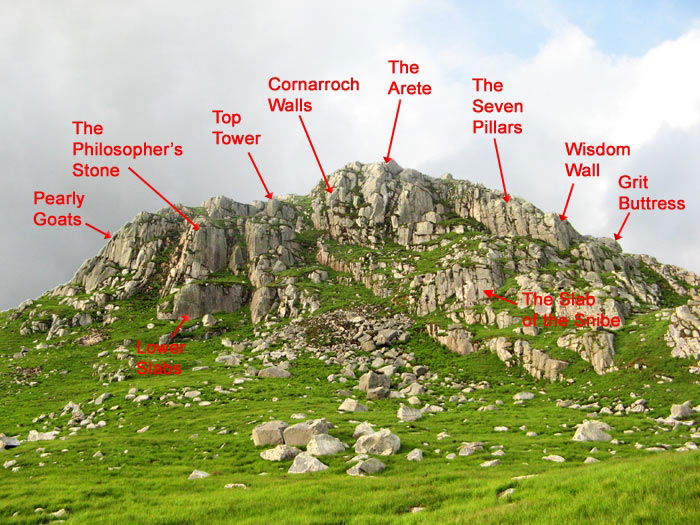
The Point of The Snibe
The cliffs consist of a number of separate buttresses. These and the climbs on them are described from right to left.
Grit Buttress
This tiny buttress lies on the very far right of the crag. The routes here are short but they have a gritstone impact.
Almscliffe V Diff 8m HVS 5b 2007
Start 2m right of the mossy central corner and climb the wall easily enough until an exit leftwards onto a sloping slab.
Goatesque 8m E2 5b 2009
The mossy central corner provides an epic and bizarre battle to gain every centimetre.
Goatzilla 8m E2 5c (2009)
Just left of the mossy corner is a short and deeply undercut arete containing a knobbly spike.
Swing out onto the spike, then puzzle out (quickly) how to stand on it in order to grovel onto the steep mossy slab above. Huff and puff your way directly up the upper wall to a horribly sloping finish.
The left arete of this buttress is a pleasant Mod.
Left again is a long broken ridge which makes a good easy scramble.
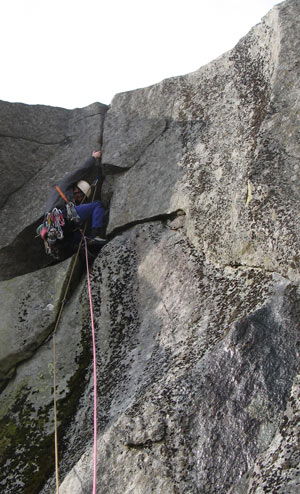
Photo above right: Chris King does his karma sutra impressions on the first ascent of Goatesque.
Below: Jonathan Hughes and Dave Jones on the first ascent of Goatzilla.
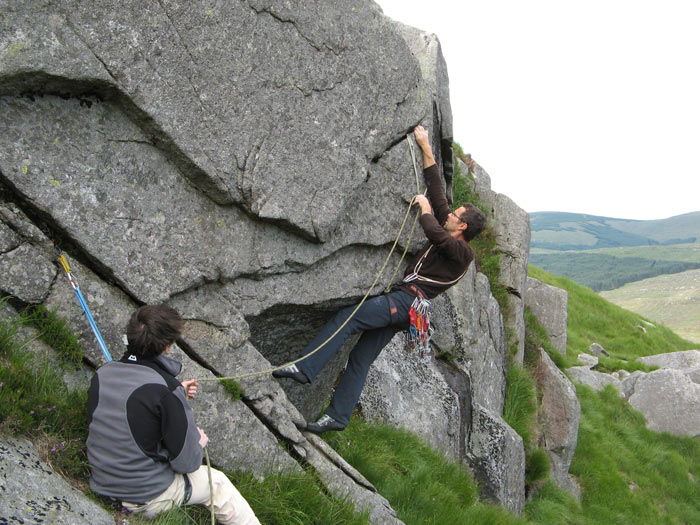
The Point of The Snibe
Wisdom Wall
This short wall lies on the far right of the crag, just right of The Seven Pillars.
Long Tall Sally 20m HVS 5b 2007
The obvious thin crack on the right of the wall has a hard move to get off the ledge.
Hooves of Fire 20m E1 5a 2007
Climb undercut flakes rightwards up the lower wall and then boldly into a scoop above. Exit up leftwards.
Photo: Wisdom Wall with Andrew Fraser on the first ascent of Hooves of Fire (E1). Swamp Fever (S) takes the left arete, more or less. (Stephen Reid)
The Seven Pillars
The right edge of the crag is marked by a rib, steep at its bottom and with a series of pillars on its left side. The rock is excellent and the climbs are easier than they look.
|
The Seven Pillars
|
| SW |
Swamp Fever |
S |
G |
Goatliness |
HS |
| MM |
McKinlay Murmerings |
VD |
BG |
Burning the Goats |
HS |
| DD |
Denali De-Brief |
HS |
AN |
Arabian Nights |
VD |
| CN |
Cleanliness is Next to … |
S |
|
|
|
Swamp Fever 13m Severe 4a (2005)
A pleasant climb climbs the bottom of the rib. Start up the boulder at the bottom left of the rib, then follow the arete above, on its left side where necessary.
The following routes take the series of pillars on the left side of the rib.
McKinlay Murmerings 5m V Diff 2005
Climb the first short rib. The chimney to its right is D.
Denali De-Brief 10m Hard Severe 4b* 2005
This climbs the first of the larger pillars, starting up cracks on its right side, then when the angle eases, climbing cracks up the centre.
Cleanliness is Next to … 12m Severe 4a** 2005
Lovely steep climbing on huge holds. To the left of Denali De-Brief is a vegetated area, then a steep buttress above a large boulder. Climb this on its right side, then to the left of the prominent detached block.
Goatliness 12m Hard Severe 4b* 2005
Another steep route with surprisingly cooperative holds. Start at the left edge of the same buttress as the previous route. Climb slightly right, then back left till feet are in the wide horizontal crack near the top. Traverse left into the chimney and up this to finish.
Photo: Ian Magill on the first ascent of Goatliness (HS). (Andrew Fraser )
Burning the Goats 10m* Hard Severe 4b* 2005
Immediately left of the previous route is a blanker pillar, which nonetheless provides a good route at a reasonable grade.
Arabian Nights 10m V Diff 2005
Left of the previous route is an area of more broken ground then a paler buttress. Climb the pale buttress then the groove above with surprising ease.
The Uncarved Block
To the left of the Seven Pillars is a cracked wall.
Pointless of the Snibe 9m Severe 4a 2006
The rounded rib at the right edge of the wall, unsatisfactorily requiring use of the turfy blocks on the right of its lower section. Continue up wall above if desired.
Timorous Cooran Beastie 10m E1 5b** 2006
Superb sustained climbing up the right-hand crack. The easiest line on the top section is not obvious.
Springs of Enchantment 15m E1 5b*** 2005
A classic route which climbs the disjointed cracks in the middle of the wall. While it dries quickly after showers, drainage from further up the hill emerges at the crux, meaning that it is rarely dry earlier in the season. Worth waiting for!
Photo: Andrew Fraser on the first ascent of Springs of Enchantment (E1). (Andrew Fraser coll.)
Ram Attang 16m VS 4c * 2005
5m left of Springs of Enchantment is a wider, rightward sloping crack which gives a fine, sustained climb. Start direct by a 5b boulder problem or as for pitch 2 of the following route. Pitches 1 and 3 of the following route can also be added.
Photo: Alasdair Gillies on the first ascent of Ram Attang (VS). (Andrew Fraser)
Silver Sand 41m VS 4c** 2005
Anther good route in a fine position. Down left of the main wall is a lower buttress with two parallel cracks at its left side. Climb the left one (9m 4b) Climb the crack up the left edge of the main wall to the heather terrace (20m 4c). From the left end of the terrace climb an easy broken rib and then a final friction slab (12m 4b).
The Arete
Across a vegetated gully from The Uncarved Block is the soaring Arete, the longest feature on the crag.
The Call of the Weird 45m VS* 2005
This route takes cracks on the right side of the Arete. Although the start is mediocre, the crux is a not-to-be-missed piece of climbing. Scramble up to gain and climb the crack on the right side of the Arete. Up this till it becomes vegetated, at which point a hitherto hidden series of foot ledges leads memorably left across the wall to gain then climb the Arete to a large heather ledge. (25m 5a) Climb the crack behind the belay, exiting right at its top to climb a rightward sloping gangway. Continue directly to the top (3m below the top it is tempting to pull out left onto a ledge on the Arete - resist the temptation as the huge block is dangerously unstable) (20m 4b).
Photo left: Ian Magill on the first ascent of The Call of the Weird (VS). (Andrew Fraser )
The Arete Direct 40m E3 6b ** (2009)
Superb climbing directly up the line of the crag. A climb with a definite crux.
Start as for The Arete and climb the short wall to the right hand side of the arete. Gain the arete and climb it to a tiny foot ledge at a horizontal break. Make a series of desperate moves directly up the arete and flop onto a heather ledge . Step horizontally left onto the continuation arete and climb this boldly to the ramp of the original route. Stand up and move up and rightwards to a large wedged block on the arete (careful now!) and so the top.
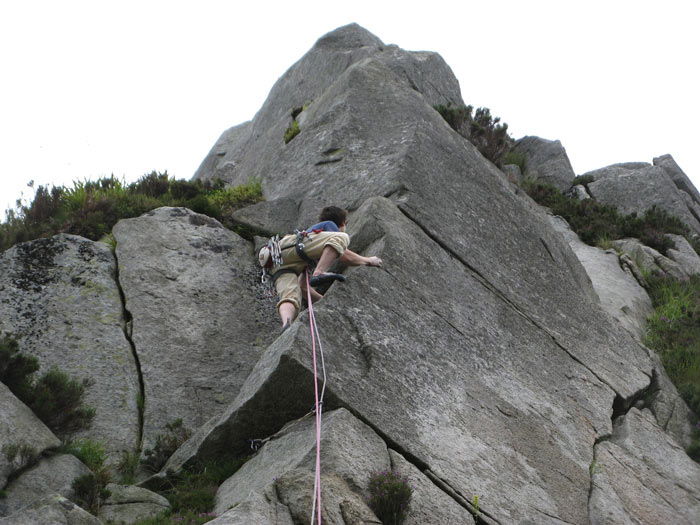
Photos: Dave Jones on the first ascent of The Arete Direct, top, Starting the main climbing, bottom left, in the middle of the 6b crux, bottom right, on the easier but bold upper section.
The Arete 50m VS* 1987
Some excellent climbing, improving with gradual vegetation removal. Start on the left side of the Arete and climb short walls to gain a corner just left of the Arete. Climb the corner (not the cleaned crack to its left) exiting left onto a large heather ledge (22m 4b). Easy cracks lead back to the crest of the Arete at a heather ledge. Follow the crack behind the ledge, exiting left onto a ramp. Follow this with difficulty to the very top, ignoring the cleaned crack near the end (28m 4c).
Worth ** (SR,CK)
Photo Ian Magill on The Arete (VS). (Andrew Fraser )
Walk on Hot Coals 47m VS** 2006
The meat of the route is the improbable slab crossed by the ramp of the Arete's top pitch. Follow the Arete to the foot of the corner on it's first pitch, and then climb the cleaned crack on the left wall of the corner (22m 4c) Move left to climb a crack at the right end of the slab, traverse left for 4m to gain a crack and gear, then move slightly back right and commit yourself to the centre of the slab. Follow this to the ramp of the Arete, which is followed left until it is possible to finish up a crack on the right wall of the ramp. (25m 4b).
John Biggar notes: We felt the top slab pitch was 4c, and close to HVS given the poor gear. Though on balance probably just VS with a warning. A very nice pitch though.
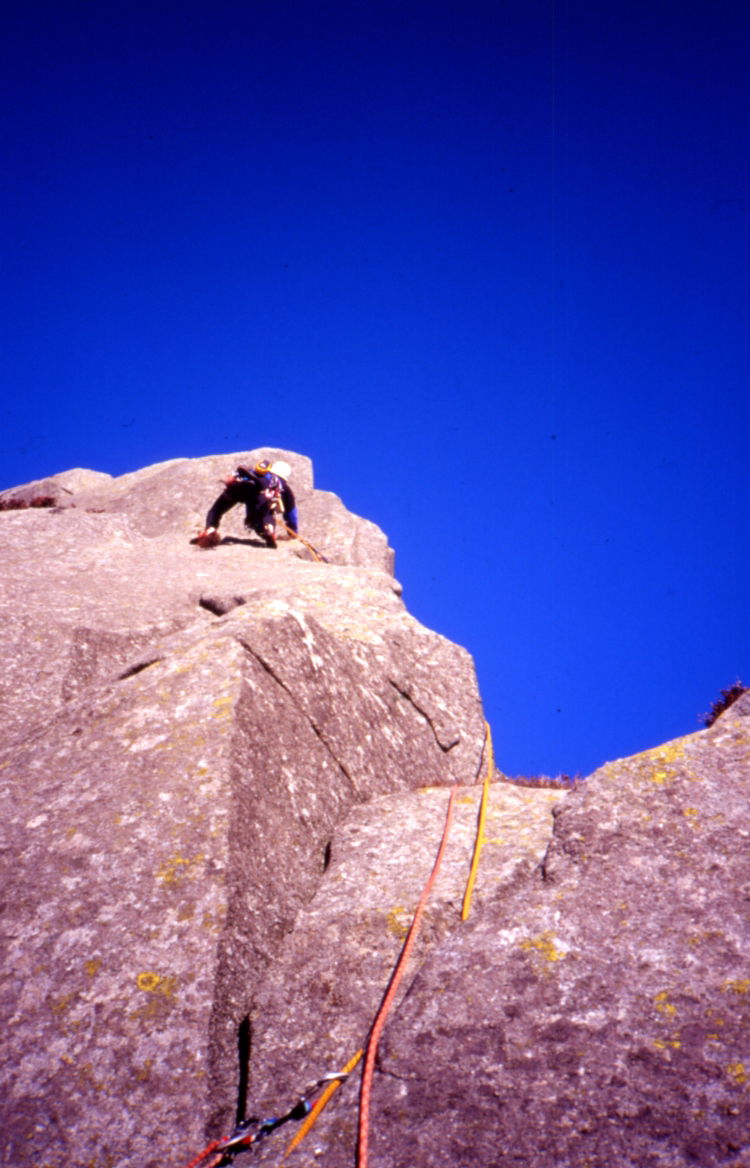
| PS |
Pointless of the Snibe |
S |
TA |
The Arete |
VS |
| TCB |
Timorous Cooran Beastie |
E1 |
WHC |
Walk on Hot Coals |
VS |
| SE |
Springs of Enchantment |
E1 |
EC |
Eau de Goat |
VS |
| RA |
Ram Attang |
VS |
CGT |
Cat Goat your Tongue? |
VS |
| SS |
Silver Sand |
VS |
CC |
Cornarroch Chimney |
VD |
| CW |
The Call of the Weird |
VS |
OR |
Original Route |
D |
| AD |
The Arete Direct |
E1 |
|
|
|
Cornarroch Walls
The following climbs are on the walls, which run up to the left of the Arete.
Eau de Goat 38m VS 2007
Start at a clean cracked rib just left of a large heather shelf at head height.
1 25m (4c). Climb cracks in the rib to heather, surmount a short wall and then twin cracks to a ledge.
2 8m (4c). Climb the right hand groove to runners, then traverse left, across the left hand groove and stride left before manteling up. A large block belay lies just above.
Cat Goat your Tongue? 25m VS 4c* 2005
About 10m left of The Arete is a slim mossy left facing corner. Gain and climb this, then move up and left to gain and climb cracks on the right side of a prominent large overhang. Above, follow the easier upper buttress to the top.
To the left are two vegetated chimneys.
Cornarroch Chimney 21m Very Difficult 1978
Climb the left-hand chimney to the heather terrace, traverse this up and left until a right sloping crack can be climbed to outflank the overhang. Finish up the buttress above.
Original Route 20m Difficult 1978
This is 3m to the left of Cornarroch Chimney. Follow the easiest line up a shallow corner to gain the heather terrace. Cross this and climb the jug-infested upper buttress to the top.
Top Tower
At the top of the wide grassy gully to the left of the Cornarroch Walls is a tower with a conspicuous steep crack on its left side.
Man the Lifegoats 9m VS 4c* 2006
The short crack gives steep climbing on good holds.
The Philosopher's Stone
Down left from the Arete is a blank wall with intermittent cracks. Below this is a short lower tier of slabs
Beltie 15m E3 5c*** 2006
Good climbing up the cracks in the centre of the wall. Low in the grade, the grade being merited by its sustained nature.
B Beltie E3
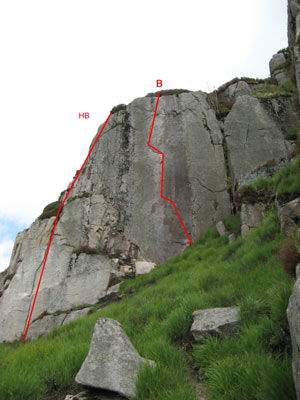
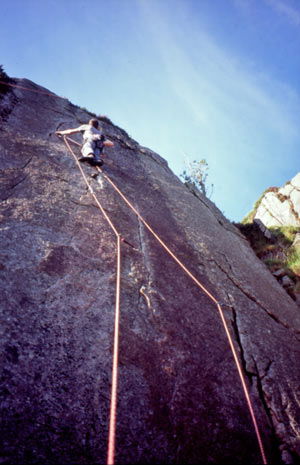
Photo Above: Dave McGimpsey on the first ascent of Beltie (E3). (Andrew Fraser ).
Photo Below: Dave Jones and Jonathan Hughes making the second ascent of Beltie.
Lower Slabs
The following three routes are on the slabs underneath the Philosopher's Stone. The Goat, the Bad and the Ugly 7m VS 5a 2006
An awkward little blighter, taking the groove at the right side of the wall. Let the Goat Times Roll 8m VS 4c* 2006
A fine climb up the cracks left of centre.
Kid's Play 8m Mod 2006
Delightfully easy climbing up cracks on the left edge.
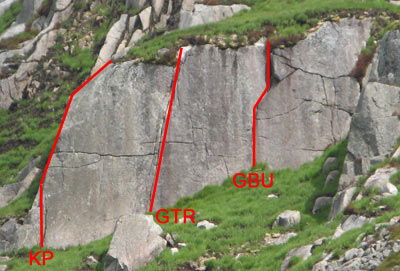
| GBU |
The Goat, the Bad and the Ugly |
VS |
| GTR |
Let the Goat Times Roll |
VS |
| KP |
Kid's Play |
M |
The Pearly Goats
Left again, at the left edge of the crag, is a two-tier buttress, the upper section of which is marked by wide parallel cracks.
|
The Pearly Goats
|
| RA |
Rivergoat Gambler |
VS |
| AD |
The Alchemists Dream |
E1 |
| FS |
The Faa Side |
VD |
| JC |
Juniper Cracks |
HVS |
| LE |
Little Egypt |
VS |
Rivergoat Gambler 28m VS 4c 2006
Much better than appearances with the vegetation only being used for one foothold. The right side of the buttress is a vegetatious gully, capped by a fine corner. To the right of the gully are two stepped ribs. Climb the scoop between these then continue up left to the fine corner. This is climbed until it is possible to escape onto a ledge on the left. Follow the rib above (crux), avoiding the easier cracks on the left.
The Alchemists Dream 35m E1 *** 2005
A powerful line giving steep jamming up the right-hand crack. Start up the right crack on the lower buttress, moving left into the scoop at mid-height, then continue up the centre of the buttress to the heather terrace below the upper wall (10m-4a) Sustained and excellent climbing up the right crack leads to a rightward-slanting scoop and cracks which are climbed to the top (25m 5b).
Probably HVS 5b - the difficulties are short and well protected. Not really ***, but definitely worth ** (SR, CK)
Photo: Ian Magill on the first ascent of The Alchemist's Dream (E1). (Andrew Fraser )
Juniper Cracks 32m HVS* 2005
Climb the left crack on the lower buttress (9m 4b). The third crack from the right is Y shaped with much juniper in the right branch of the Y. Climb a combination of the next crack to the left and the left branch of the Y until it is possible to move right above the juniper to gain a groove. Climb this groove to a heather ledge then climb the short wall above (23m 5a).
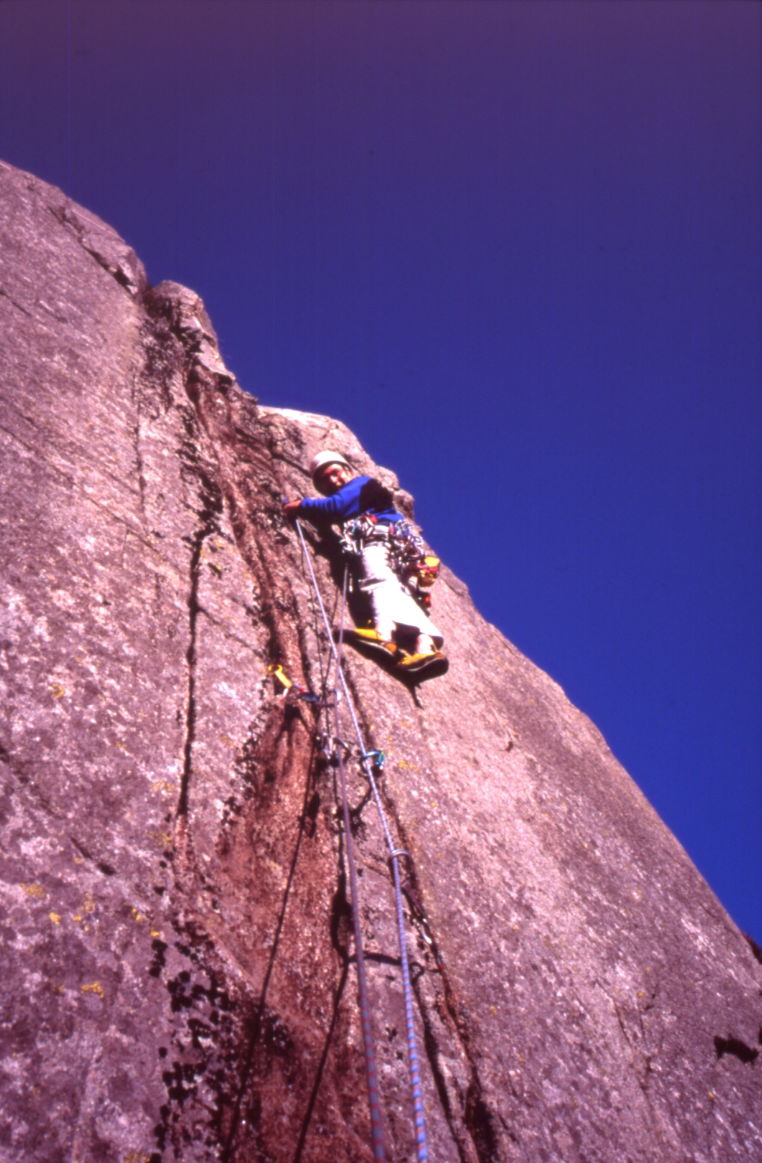
Little Egypt 30m VS* 2005
5m left and down from pitch 2 of Juniper Cracks is a recessed cracked slab. Climb cracks at the right side of this, before moves lead up left across the slab to gain the thank god grass ledge at its left end. The steeper wall above is liberally endowed with holds and provides very agreeable climbing to the top.
Quite pleasant but rather dirty - not really worth a star (SR, CK).
The Faa Side 45m VD 2005
The ridge at the left end of the crag. The second and third tiers are climbed on the left side by a crack and slab respectively. The climb includes the slabby buttress of clean rock lying just above the main ridge.
| Point of the Snibe - First Ascents |
| 1950s |
Two untraced Difficults |
A Gordon Waldie |
| 1978 23 May |
Original Route |
Andrew Fraser, Kelvin Donaldson |
| 1978 23 May |
Cornarroch Chimney |
Andrew Fraser, Kelvin Donaldson |
| 1987 |
The Arete |
Adrian Plumb, Sandy Aird |
| 2005 14 May |
Silver Sand |
Andrew Fraser, Alastair Gillies |
| 2005 14 May |
Ram attang |
Alastair Gillies, Andrew Fraser |
| 2005 14 May |
Cat Goat your Tongue? |
Alastair Gillies, Andrew Fraser |
| 2005 14 May |
Cleanliness is Next to… |
Andrew Fraser, Alastair Gillies |
| 2005 24 Jul |
Denali De-Brief |
R (Bob) Pontefract, Ian Magill, Andrew Fraser |
| 2005 24 Jul |
Burning the Goats |
Ian Magill, R (Bob) Pontefract |
| 2005 24 Jul |
McKinlay Murmerings |
R (Bob)Pontefract |
| 2005 24 Jul |
Springs of Enchantment |
Andrew Fraser, Ian Magill, R (Bob) Pontefract |
| 2005 24 Jul |
Arabian Nights |
R (Bob) Pontefract, Ian Magill, Andrew Fraser |
| 2005 24 Jul |
Goatliness |
Ian Magill, R (Bob) Pontefract, Andrew Fraser |
| 2005 20 Aug |
Swamp Fever |
Andrew Fraser, Ian Magill |
| 2005 20 Aug |
The Call of the Weird |
Andrew Fraser, Ian Magill |
| 2005 29 Aug |
The Faa Side |
Andrew Fraser, Ewen Magill, Ian Magill |
| 2005 29 Aug |
Little Egypt |
Andrew Fraser, Ewen Magill, Ian Magill |
| 2005 29 Aug |
The Alchemist's Dream |
Ian Magill, Andrew Fraser, Ewen Magill |
| 2005 29 Aug |
Juniper Cracks |
Andrew Fraser, Ewen Magill, Ian Magill |
| 2006 24 Jul |
Pointless of the Snibe |
Andrew Fraser, Dave MGimpsey |
| 2006 24 Jul |
Beltie |
Dave MGimpsey, Andrew Fraser |
| 2006 24 Jul |
Kid's Play |
Andrew Fraser |
| 2006 24 Jul |
Let the Goat Times Roll |
Andrew Fraser, Dave MGimpsey |
| 2006 24 Jul |
The Goat, the Bad and the Ugly |
Dave McGimpsey, Andrew Fraser |
| 2006 17 Sep |
Man the Lifegoats |
Ian Magill, Andrew Fraser |
| 2006 17 Sep |
Walk on Hot Coals |
Andrew Fraser, Ian Magill |
| 2006 17 Sep |
Timorous Cooran Beastie |
Andrew Fraser, Ian Magill |
| 2006 17 Sep |
Rivergoat Gambler |
Ian Magill, Andrew Fraser |
| 2007 10 Jun |
Long Tall Sally |
Stephen Reid, Andrew Fraser |
| 2007 10 Jun |
Hooves of Fire |
Andrew Fraser, Stephen Reid |
| 2007 30 Aug |
Eau de Goat |
Andrew Fraser, Stephen Reid (alt) |
| 2007 30 Aug |
Almscliffe V Diff |
Stephen Reid, Andrew Fraser |
| 2009 3 Apr |
Goatesque |
Chris King (unseconded) |
| 2009 8 Jul |
The Arete Direct |
David Jones, Jonathan Hughes, Stephen Reid |
| 2009 8 Jul |
Goatzilla |
Jonathan Hughes, David Jones |